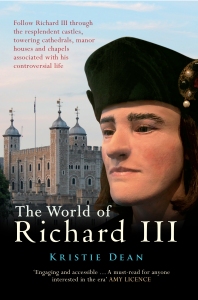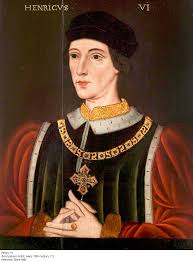King Richard III is a very interesting character that many people have lots of different opinions on. His life seems to be full of intrigue and mystery with plenty of controversy. Whether it is the story of the princes in the tower, war with Scotland, numerous rebellions, then his death at the Battle of Bosworth Field or the recent finding of his body under a car park, there is enough for everything to find something to peak their interest.
Recently I have been lucky enough to be able to look at an upcoming book regarding Richard. ‘The World of Richard III’, by Kristie Dean and published by Amberley Publishing and is due out later this year.
The book is a historical tour guide of places that are associated with the king. It is broken down into seven different sections from Richard’s early life, through his brother’s reign, then his own kingship to his death. I like that it includes a family tree of the York family and also a map giving you each location represented on the British Isles. A lot has been made in the media recently about Richard and his final resting place with the finding of his skeleton in the car park in Leicester. So I have decided for this post I want to take a look at the places that shaped Richard’s early life.
The following is an extract from the book;
‘All that is left of the once impressive castle is a grassy mound by the river and a few fragments of masonry from the keep. Standing here, it is hard to picture the busy, bustling place the fortress once was. It is almost as if the execution of Mary, Queen of Scots, held in the Great Hall of Fortheringhay in February 1587 left an indelible mark of sadness on the area.’
Richard III was born on 2nd October 1452 at Fotheringhay Castle. The last son of Richard, 3rd Duke of York and Cecily Neville no one would ever of expected him to reach the heights of king. The castle that Richard was born in was roughly about 350 years old at his birth. William I granted the area to Judith of Lens who was the wife of Walteof, Earl of Northumbria. Their daughter Maud married Simon de Senlis who was made Earl of Huntingdon and around 1100 he founded Fotheringhay Castle.
The story of the castle takes a twist with the lords becoming Scottish. de Senlis was dead by 1113 and King Henry II then arranged for Maud to marry the future king of Scotland David. David then acquired Fotheringhay as well as other properties in Huntingdonshire. The castle then followed through the Scottish royal family into the 13th Century. The first known documented evidence of the castle was when King John, who had hostages from many of his barons to ensure their loyalty acquired the castle. John had David, Earl of Huntingdon’s son and wrote ‘You have given us your son as hostage, therefore we require you to yield to us your castle at Fotheringhay.’ Baron’s were not happy that the king was claiming all their castles and to try and appease them John started reversing his actions in 1215 and Fortheringhay was returned to David. Shortly after David rebelled against the king and the castle was awarded to William Marshall, 2nd Earl of Pembroke. There was disputes regarding the castle between Marshall and David. David died and Alexander II of Scotland laid claim to the castle and eventually it was to form part of the dowry of Joan, Henry III of England’s sister who was to marry the Scottish king. Marshall finally gave the castle over to the English king on 3rd December 1219.
During the rest of the 13th Century the castle changed hand many times. Edmund Langley, son of Edward III of England obtained the castle in 1377 becoming his principle seat when he became Duke of York in 1385. Langley died in 1402 and the castle passed down to his eldest son Edward. Edward died childless and after moving to his brother the castle went on to his son Richard. Richard (father of Richard III) was Duke of York and husband of Cecily Neville. They went on to become the parents of two kings, Edward IV and Richard III. Richard the elder became ‘protector and defender of the realm’ on 27th March 1454 while Henry VI, suffered from mental illness.
During the War of the Roses, Richard died at the battle of Wakefield in 1460, but the castle didn’t come out of favour and his now widowed wife entertained greatly at the castle. Elizabeth Woodville, Edward IV’s queen resided at the castle in 1469. The castle was given by Henry VIII to his wife Katherine of Aragon who spent a lot of money on the castle restoring it and bringing it up to date.
Another famous chapter in the castle’s history was the beheading of Mary, Queen of Scots. Her trial took place in the Great Hall at Fotheringhay on the 14th and 15th of October 1586. Found guilty on the 25th October and then told on the 7th February the following year that her execution would take place on the next day.
Despite the castle size and previous importance it was left to ruin and within 50 years of Mary’s execution it was reported to be in a ruinous state and completely demolished soon afterwards.
‘A moat surrounded the castle and the entrance would have been through a gatehouse. The great stone keep would have sat atop the mound surrounded by a wall and would have been accessible through steps leading from the inner bailey to the top. During the time of Marie de St Pol, the castle was said to have a large hall, two chambers, two chapels, a kitchen, a bake house and a porter’s lodge. When Richard lived there, the windows might have been ornamented by a falcon enclosed in a fetterlock, which was an emblem of the House of York.’ Another extract from the book  Today the castle is a scheduled monument of national importance, historical building and archaeological site. There is little today except for the earthworks and some masonry remains. Fotheringhay is open to the public during daylight hours and provides views along the Nene valley demonstrating it’s excellent defensive position.
Today the castle is a scheduled monument of national importance, historical building and archaeological site. There is little today except for the earthworks and some masonry remains. Fotheringhay is open to the public during daylight hours and provides views along the Nene valley demonstrating it’s excellent defensive position.
The World of Richard III by Kristie Dean is published by Amberley Publishing, 2015. The book is available to buy at all good bookstores, as well as online at the Amberley website, Amazon and The Book Depository.






